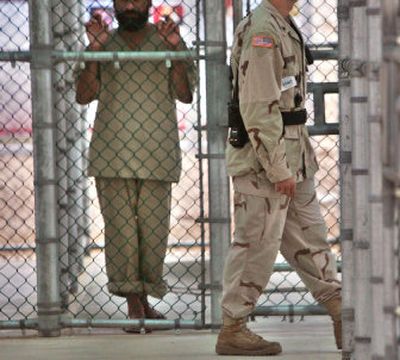Detainee realm entering public view

WASHINGTON – The secret interrogation of senior al-Qaida aide Abu Zubaydah provided U.S. authorities with the clues they needed to capture the alleged mastermind of the Sept. 11, 2001, attacks and other key terrorism suspects around the world, according to new accounts provided Wednesday by President Bush and administration officials.
In announcing the transfer of Zubaydah and 13 other “high value” terrorism suspects to the U.S. military prison at Guantanamo Bay, Cuba, Bush disclosed extensive new details about what he called “tough” interrogation methods, which human rights advocates have condemned as torture. But Bush defended an “alternative set of procedures” for interrogations that he said offered critical information about links between suspected terrorists and helped thwart eight plots aimed at killing Americans.
The group of suspects is an apparent who’s who of al-Qaida and its affiliates, including alleged Sept. 11 mastermind Khalid Sheik Mohammed and the Indonesian extremist leader known as Hambali, who is blamed for bombings in Bali and the Philippines. Officials said the group also includes those suspected in the bombing of the USS Cole in Yemen in 2000 and the bombings of U.S. embassies in Kenya and Tanzania in 1998.
The announcement raises the possibility that, after being held for years in secret CIA prisons in Eastern Europe and elsewhere, Mohammed and others accused of planning and executing the Sept. 11 attacks may be publicly tried. So far only one person – Zacarias Moussaoui – has been tried in connection with the plot. The al-Qaida operative was convicted.
But such tribunals would also raise a host of thorny legal issues, including whether information gleaned from aggressive interrogation methods would be admissible at trial and whether the defendants would be able to see the evidence against them.
Legislation proposed by the administration would allow the use of hearsay evidence, permit use of classified information without showing it to the defendant and allow evidence obtained through coercion.
“It’s the rogue’s gallery of al-Qaida, the crown jewels of who we have,” said Bruce Hoffman, a terrorism expert and Georgetown University professor. “But in attempting to resolve their status, the last thing you want is to give any impression that it’s going to be a kangaroo court.”
Intelligence officials said the suspects were transferred in secret over the past several days. But the prisons in which they were held, while now empty, are not closed, and officials said CIA staff are continuing to maintain a presence at the facilities.
The public confirmation of the 14 men completes a list of all known detainees in U.S. custody, following the disclosure in May of others being held at Guantanamo Bay.
Overall, nearly 100 detainees had been held in the secret CIA prisons, officials said. Most were either transferred to jails in other countries, where they could be interrogated and held without trial, or set free, intelligence officials said.
In a series of documents released by the director of national intelligence (DNI) Wednesday, authorities provided startling new details about the CIA prison program, which had been wrapped in secrecy. At the same time, the information was carefully edited and included little if any information on how the detainees were arrested, how information was gathered and assessed, and where the prisoners were held or moved.
The 14 detainees can be roughly divided into two groups: those allegedly associated with al-Qaida and the Sept. 11 attacks, and those suspected of having ties to Hambali and Jemaah Islamiyah, a Southeast Asian extremist group linked to al-Qaida.
The alleged Sept. 11 conspirators in the group include Mohammed, Zubaydah, lead operative Ramzi Binalshibh and financier Mustafa Ahmad Hawsawi. The list also includes Majid Khan, a Pakistani national who worked at a family gas station in Baltimore and allegedly was selected by Mohammed to blow up gas stations and participate in other plots in the United States.
The DNI documents portray the capture and intermittent interrogations of Zubaydah as crucial to unraveling much of what the government knows about the Sept. 11 attacks and the internal operations of al-Qaida. But some of the portrayal appears to be at odds with other published reports, and intelligence sources indicated Wednesday that Zubaydah’s case is more complicated than the administration indicated.
Zubaydah “was wounded in the capture operation” in Pakistan in March 2002, and “likely would have died” if the CIA had not provided medical attention, according to the documents. During an initial interrogation, he provided information “that he probably viewed as nominal,” but which included identifying Mohammed as the Sept. 11 mastermind who used the nickname “Mukhtar,” the documents say. The information “opened up new leads” that eventually resulted in Mohammed’s capture, the documents say.
But in his recent book, “The One Percent Doctrine,” Ron Suskind reported that a tipster led the CIA directly to Mohammed and subsequently collected a $25 million reward. Intelligence sources said Wednesday that the Suskind description was correct, but that Zubaydah’s information was also helpful.
What the DNI documents also do not mention is that the CIA already had identified Mohammed’s nickname in August 2001, according to the Sept. 11 commission report.
When Zubaydah refused to provide further information, the CIA designed a new interrogation program that would be “safe, effective and legal,” the DNI documents say, leading to “accurate and highly actionable intelligence” that led to the capture of Binalshibh.
The DNI document outlines Mohammed’s alleged role in launching a series of other plots before his capture in Rawalpindi, Pakistan, in March 2003. One involved having South Asian terrorists associated with Jemaah Islamiyah hijack an airliner over the Pacific and crash it into a West Coast skyscraper. Another was to use Pakistanis in early 2003 to smuggle explosives into New York City and hit gas stations, railroad tracks and a bridge.